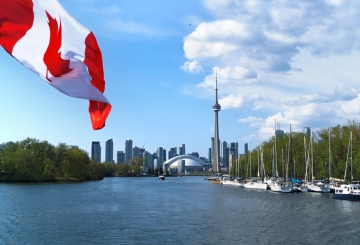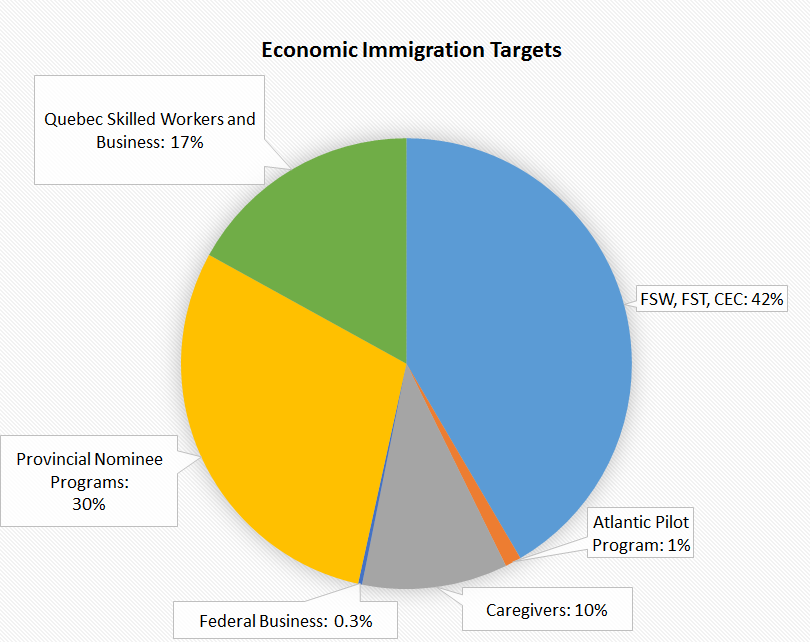Immigration Plan 2017: Canada to Welcome Increased Number of Immigrants Through Economic and Family Sponsorship Programs
 The government of Canada has released its widely anticipated immigration plan for 2017, and the news looks good for individuals looking to immigrate to Canada through one of the economic or family sponsorship programs.
The government of Canada has released its widely anticipated immigration plan for 2017, and the news looks good for individuals looking to immigrate to Canada through one of the economic or family sponsorship programs.
Key highlights:
- Target number of newcomers through Federal Skilled Worker Class, Federal Skilled Trades Class, and Canadian Experience Class increases by 23 percent.
- Government aims for 51,000 new immigrants to come through the Provincial Nominee Programs.
- Quebec aims to welcome more than 29,000 through economic programs, including the Quebec Skilled Worker Program.
- Economic immigration to make up a larger share of overall immigration than in 2016.
- More spouses, partners, children, parents and grandparents to arrive through Family Class sponsorship programs.
Although the plan targets an increase in economic immigrants and sponsored persons, the target figures for the Refugees and Protected Persons immigration categories are down compared to the 2016 plan. However, the overall target for these programs, set at 40,000, remains far higher than at any time during the previous Conservative government’s tenure.
Overall, Canada may welcome as many as 320,000 new immigrants over the calendar year of 2017. The increased scope presented by the government — the plan for 2016 allowed for up to 305,000 newcomers — is likely reflective of a desire to increase immigration over the coming years in order to respond to labour shortages and demographic challenges. Earlier this year, Immigration Minister John McCallum said that "there's a significant feeling that Canada does need more immigrants, partly because we have an aging population, and so we need more young blood to keep our economies going."
Before announcing the plan on October 31, 2016, Minister John McCallum met with stakeholders across the country. In a statement, he said that “the 2017 levels plan will put Canada in a strong position for the future and support our overall economic and social development as a country.”
Immigration Category |
2017 Target |
2016 Target |
Percentage Difference, 2016 to 2017 |
Economic Total |
172,500 |
160,600 |
+7.41% |
Family Total |
84,000 |
80,000 |
+5% |
Refugee and Humanitarian |
43,500 |
59,400 |
-26.77% |
Target range |
280k–320k |
280k–305k |
+4.92% (higher range) |
Target |
300,000 |
300,000 |
No change |
To view a full breakdown of the various immigration programs under each of these categories and the target immigration numbers for 2017, click here.
Express Entry: Significant increase in ITAs to be issued in 2017
Of all the changes that have been made for the 2017 plan, arguably the most significant is the increased role that Canada’s Express Entry immigration selection system is expected to play next year. Express Entry, which was first launched in January, 2015, is a system used by Immigration, Refugees and Citizenship Canada (IRCC) to select candidates for immigration to Canada through the following economic immigration programs:
Together, up to 75,300 new immigrants will land in Canada through one of these programs in 2017. This includes applicants who applied prior to the launch of Express Entry and whose applications remain in the inventory of applications that have not yet been processed to completion. Last year, the government set an upper target range of 59,000 for these programs. Moreover, the inventory of applications submitted before 2015 was larger at that time. Consequently, the number of people to be invited to apply for Canadian permanent residence through Express Entry in 2017 is expected to go up considerably.
The past few weeks have seen a distinct upswing in Express Entry activity, and this may be a sign of things to come in 2017. The most recent draw, which took place on October 19, was the largest ever, and the number of Invitations to Apply (ITAs) issued per draw has increased for each of the past four draws.
Provincial Nominee Programs
Around 51,000 (potentially up to 54,000) new permanent residents will come through the Provincial Nominee Programs (PNPs), representing an increase from 47,800 in 2016. Most provinces and territories have ‘base’ PNP streams, as well as ‘enhanced’ categories aligned with the Express Entry system.
The PNPs allow provinces and territories to nominate individuals who wish to immigrate to Canada and who are interested in settling in a particular province or territory. Over the past couple of years, these programs have become more varied in scope and increasingly dynamic in their approach to bringing newcomers to the provinces.
British Columbia, for example, has successfully introduced an exciting new system (the Skills Immigration Registration System) for attracting and ranking candidates. Meanwhile, Saskatchewan has been active both within and outside the Express Entry system, Manitoba continues to conduct draws from its pool of skilled worker candidates, and Alberta continues to process applications across a range of categories.
Further east in Ontario, 2016 was such a busy year that the province had to place a temporary pause on some popular PNP streams. That being said, next year may well see even more PNP activity from Canada’s most populated province. The Maritime provinces along the east coast also remain active with their PNPs, attracting individuals from different backgrounds and with various occupations. In addition to these popular categories, the Atlantic Immigration Pilot Program — a new initiative between the federal government and eastern provinces — will be launched in earnest in 2017, bringing up to 2,000 more newcomers to Eastern Canada through this program alone.
There are a couple of things that are worth noting about the PNPs as we enter 2017. First, individuals who may not be eligible to enter the Express Entry pool (for example, because of limited language proficiency) may be eligible to immigrate to Canada through a PNP. Second, and contrary to much popular opinion, some PNP categories do not require individuals to have a previous connection to the province, and some PNP categories do not require individuals to have a job offer.
The PNPs may also prove to be the pathway to permanent residence for international graduates who have completed their studies in Canada, as well as entrepreneur immigrants looking to settle in Canada.
Quebec remains a force
With a new Expression of Interest-style immigration system expected to be launched at some point in the future, 2017 could be an interesting year for Quebec’s economic immigration programs. This unique province, which has a separate immigration agreement with the government of Canada, welcomes skilled workers, investors and entrepreneurs, as well as individuals with experience of working or studying in the province.
Last week, Quebec’s Immigration Minister Kathleen Weil doubled down on a plan to maintain annual immigration levels above 50,000 for the coming year, despite political opposition. With a target of up to 31,200 to come through Quebec’s economic programs, Quebec will remain a force in the overall Canadian immigration landscape.
Economic immigration overall
Economic immigration supports Canada’s long-term economic priorities, with the goal of improving livelihoods for Canadians and newcomers alike, while also improving Canada’s global competitiveness. The chart below shows the full range of Canada’s economic immigration categories, and their percentage share within the overall target for economic immigration to Canada in 2017.

Economic Immigration Program |
2017 Levels Plan Target |
Skilled (FSW, FST, CEC) |
71,700 |
Atlantic Immigration Pilot Program |
2,000 |
Federal – Business |
500 |
Provincial Nominee Programs |
51,000 |
Quebec Skilled Workers and Business |
29,300 |
Caregivers |
18,000 |
Overall |
172,500 |
Reuniting more families in Canada
Before the Liberal Party won last year’s federal election, leading party members, including the current Immigration Minister John McCallum, made it clear that Canada’s family sponsorship programs needed to be more of a priority in a number of ways. This includes increasing the number of sponsored immigrants, reducing processing times, and removing the conditional permanent residence provision on certain sponsored spouses and common-law partners.
Towards this end, the government has made a number of positive changes. The 2017 Immigration Plan reveals a government target of 84,000 sponsored immigrants through family sponsorship programs, including 64,000 spouses, partners, and children, as well as 20,000 parents and grandparents.
Moreover, the government plans on repealing the conditional permanent residence regulatory provisions for certain sponsored spouses and common-law partners. If approved, the change is expected to come into force in spring 2017. Finally, the government has also made strong headway on reducing family sponsorship processing times: the latest figures show an overall reduction in processing times of 15 percent over the past year.
Continuing growth, beneficial for all
“Over the past few months there has been much talk, both across Canada and around the world, about immigration. And of all the countries in the world, Canada continues to stands out as a beacon of hope,” notes Attorney David Cohen.
“Compare Canada to the rhetoric coming out of Australia, the United States, and much of Europe so far this year. It is markedly different, to say the least. What the government of Canada’s 2017 Immigration Plan shows is a commitment to growth, economic and social. It is as much about bringing the world’s best and brightest as it is about ensuring that their family members, as well as the family members of Canadians, can join them here quickly.
“Finally, it is crucial that Canada maintains its welcoming attitude towards those who need protection the most, namely refugees, and this plan retains a high share of refugees and protected persons within the mix.”
To find out if you are eligible for immigration to Canada through one of the many programs currently available, please fill out a free online assessment today.
To find out if you or your spouse, partner or dependent(s) is eligible for sponsorship under the Family Class, please fill out a free online family class assessment. To find out if you or your family members are eligible for the Parent and Grandparent Program (PGP), please fill out a free parental sponsorship assessment today.
© 2016 CICNews All Rights Reserved
- Do you need Canadian immigration assistance? Contact the Contact Cohen Immigration Law firm by completing our form
- Send us your feedback or your non-legal assistance questions by emailing us at media@canadavisa.com





